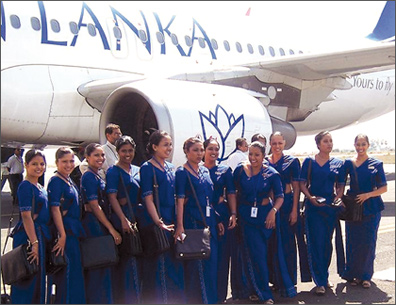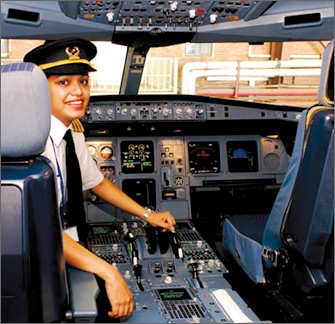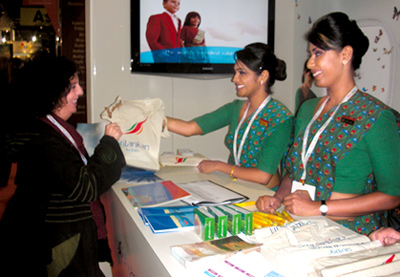Int'l Civil Aviation
Day Dec. 7 :
Sky is the limit
by Shirajiv SIRIMANE
|

Construction site of Hambantota Airport.
|
Ceylon first saw an aircraft in the 1930s when the then Transport
Minister Sir John Kotelewela initiated an aero training school in
Ratmalana. However more serious flying was seen after almost a decade
when aircrafts were used to drop essential items for flood victims all
over the country.
In 1934, the State Council of Ceylon (as it then was) made a decision
to construct an aerodrome within reach of the capital city of Colombo
and decided on Ratmalana as the best site. On 27 November 1935 a de
Havilland Puss Moth flown by Tyndalle Bisco, Chief Flying Instructor of
the Madras Flying Club, was the first aircraft to land at the new
airport.
During the Second World War it was used as an Royal Air Force base
with No 30 Squadron flying Hawker Hurricanes from there against Japanese
Navy aircraft. QEA flew civilianised Consolidated B-24 Liberator and
Avro Lancastrian aero planes there from Perth, Western Australia, on
what was at the time the world's longest non-stop air route. The flight
continued after the war with an intermediate re-fueling stop at the
Cocos Islands.
|

In a bid to make air travel affordable to every one Mihin Lanka
was launched two years ago. |
During world war two many military planes were seen over Colombo and
people even saw Japanese flights being gunned down. Since the 1980s the
airfield has been operated by the Sri Lanka Air Force as the SLAF
Ratmalana with several operational squadrons based there.
Today, many domestic airlines use the airport to fly to Palaly,
Trincomalee and other destinations. Air Ceylon was Ceylon's (later Sri
Lanka's) national carrier, commencing scheduled operations in December
1947, and was fully state-owned. It ceased operations in 1978 and was
replaced by AirLanka.
Initial services which were domestic and regional, used Douglas DC-3
Dakotas. The home base was Colombo-Ratmalana Airport. On 21 December
1949, an Air Ceylon Douglas DC-3 crashed at Trichinopoly, India.
International services commenced in 1949 in partnership with Australian
National Airways (ANA) using two Douglas DC-4 Skymasters named `Laxapana'
and `Ratmalana'.
The ANA partnership ceased in 1953.
In 1956 a partnership arrangement commenced with KLM Royal Dutch
Airlines, which provided a Lockheed 749 Constellation on wet-lease for
international services. This was later replaced by a Lockheed 1049 Super
Constellation, and later still, a Lockheed 188 Electra turboprop.
|

One of the lady pilots of SriLankan airlines. |
In 1962, in a pool partnership with BOAC, international services from
Colombo-Katunayake to London were started, using de Havilland Comet 4
jetliners. The Comet 4s were replaced by Vickers (BAC) VC10s in 1967
Following bankruptcy the airline was closed down by the Government of
J.R. Jayawardene in 1978.
Though many people still talk about Ratmalana only a few knew that a
second airport did exist at Puttalam and was abandoned due to logistic
problems. The government then started looking for a suitable
international airport and subsequently they decided on Katunayake. The
airport began as a Royal Air Force base during the Second World War, RAF
Negombo. In 1957, when S. W. R. D. Bandaranaike removed all the British
Military Bases from Sri Lanka (Ceylon), the base was handed over to the
Royal Ceylon Air Force (RCyAF) and renamed Katunayake. Part of it still
remains an Air Force base.
In 1964 Anil Moonesinghe, the Cabinet Minister of Communications
started the building of a new international airport to replace Ratmalana,
with Canadian aid. The airport was completed in 1967, and Air Ceylon,
the national carrier, began international operations using a Hawker
Siddeley Trident and a leased British Overseas Airways Corporation
(BOAC) British Aircraft Corporation (BAC) VC-10. The airport was also a
Trans World Airlines (TWA) hub for a short time.
It was named Bandaranaike International Airport (BIA) after former
Prime Minister S. W. R. D. Bandaranaike in 1970. It was renamed
Katunayake International Airport in 1977 but was changed back to
Bandaranaike International Airport in 1995.
Expansion projects have been undertaken at Bandaranaike International
Airport. A pier with eight aero-bridges opened in November 2005. On May
7, 2007 the Sri Lankan Government decided to shift some major military
aviation out of the space adjoining the airport to SLAF Hingurakgoda,
paving the way for more civilian operations.
Today, even domestic flights are being operated. The airport is
undergoing resurfacing of its runway. It has been announced as of
December 3, 2009, that its current runway will be expanded to 3,350
metres. Future projects may include a second runway to support the
Airbus A380, the largest commercial airliner in the world, a further
eight passenger gates, a domestic terminal, a 5-storey car-park, and a
five-star hotel neighbouring. New approach channels into the airport
will be created.
|

Some of the SriLankan airline staff at the World Tourism market
in London. |
Launching of an airline for Sri Lanka was another major landmark for
the country and to fulfil this obligation 'Air Lanka' was formed by the
Government of Sri Lanka, in July 1979, following the termination of Air
Ceylon, in 1978. Sri Lankan Airlines started its operations in a humble
way, with a fleet consisting of only two Boeing 707 jets, which were
bought on lease, from Singapore Airlines. Over the years, Sri Lankan
Airlines has grown and now, it operates scheduled flights to a number of
international destinations in Asia and Europe, with the help of its
modern fleet of aircrafts. Check out more information on the profile and
history of Sri Lankan Airlines. Since its inception in July 1979,
AirLanka increased its number of destinations and added more aircrafts
to its fleet come the advent of the 1990s decade, the airline possessed
a number of sophisticated aircraft and served 26 destinations.
In 1992, the airline purchased its first Airbus A320. The State-owned
airline was partially privatized in 1998 when the Dubai based Emirates
Group signed an agreement with the Sri Lankan Government. As per the
agreement, Emirates Group was bestowed with exclusive rights for all the
aircraft ground handling and airline catering at the hub of AirLanka at
Colombo-Bandaranaike airport for a period of ten years. With many
international airlines patronizing the Colombo airport a demand for a
second international airport was needed and thus Hambantota
international airport project was launched on November 27 by President
Mahinda Rajapaksa. The airport, which would fill a big void, would be
constructed on 800 hectares of bare land and with an investment of Rs.
22 billion with foreign funding. The airport, in the first stage, would
consist of one runway and a taxiway and under the second stage it would
be expanded allowing bigger aircraft like A380s to land. With the ending
of the war, a tourist boom is expected. Already 13 domestic airports
such as Palali and Trincomalee are being upgraded and many new airlines
are set to fly to Colombo and the Colombo sky would be a hive of
activity in time to come.
|

